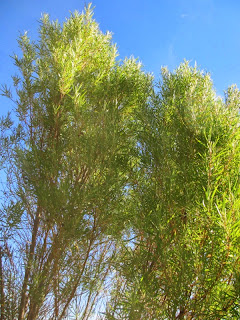Every time we try out a different route, we come across something 'new'! Nothing earth-shattering, and we wanted to come back on a familiar route to check the Agapanthus walshii.
Many of the Nymphea nouchali in the Experimental Farm dam are now high and dry, yet they are still producing beautiful flowers:
At the Railway gangers' ruins, the Prickly Pear is still flowering. We found some eaten fruits, but didn't know whether by human or animal.
Bird-life isn't plentiful on our walks; there were swallows (flying low, which my grandfather used to say was a sign of rain on the way), but we are familiar with the Stonechat in one area:
The veld is still dotted with Stoebe spiralis:
The flowers do look spiky, but it's only when they're blown up like this that one can see the trumpets
We haven't noticed this bush before, with red berries, some of which have turned black, others have dried up completely:
Then what we assume is a Leucadendron, two tall bushes together, female with many cones?
And next to it, with the remains of small star-like dry flowers, the male?
While some of the Ericas are turning brown, others are still vividly in flower:
We just couldn't walk past this one without inspecting it more closely, the flower within a flower makes it probably Erica coriifolia. Carpobrotus edulis or Sour fig on the left:
What we think is Brabejum stellatifolium, Wild Almond as in van Riebeeck's hedge:
It is growing like a hedge here!
Then we moved into the forest where we hadn't been for a long time and immediately noticed something like a Pseudoselago serrata, but taller, and the forming flowers were much longer than the 'normal' one:
Is this something different, or is it just that it's growing in the shade? This below is one of those we're more familiar with, seen later on the walk:
The Kirstenbosch book No 5, Stellenbosch to Hermanus, says that at fruiting time, the heads elongate into structures looking like long heads of barley. Is that what's happening?
The pink Tritoniopsis are looking beautiful:
We think they're T. lata and today looked in detail at the individual flowers:
Also in some of the identification pictures of T.lata, the white shows on each side of the red stripe, as seen here:
Back on familiar ground where we recently found a Lobelia jasionoides. I had forgotten how small the flowers were, so here is the whole plant with a half-litre water bottle (picked up litter!) for comparison:
And the flowers with the cap:
The 'other' Stoebe, S. plumosa, also called Seriphium plumosum, or locally Slangbos, is also in flower:
The flowers are quite different from the S.spiralis:
The Liparia splendens or Mountain Dahlia is completely covered in buds, yet the flowers only seem to be opening one by one!
We were struck by the unusual shape of this Erica bush, so smooth and compact:
The leaves were also short and tight against the stems:
A Teedia? Or is it an Oftia? We'll have to wait and see what colour the flowers are when they come!
We have not previously noticed this Restio (or is it one?) with foliage around the base. At first we thought it was growing through another plant, but there were several of them in this area. Any ideas?
This one we saw on display yesterday at Fernkloof, but neglected to note its name. At Vogelgat Private Nature Reserve near Fernkloof, 39 Restios are recorded, so finding the right name is a tall order!
As usual, there was a lot more, but it's nice to check other areas from time to time! One last picture, again at the Gangers' houses on the way home, Amaryllis belladonna at its best. The garden is completely derelict, yet they keep coming up!
:-) A
| ||
Sunday, 16 March 2014
Sunday Flower Walk on a Different Route
Labels:
Amaryllis,
Brajejum,
Erica,
Liparia,
Lobelia,
new,
Nymphea,
Pseudoselago,
Restio,
Seriphium,
Stoebe,
Tritoniopsis
Location:
Grabouw, South Africa
Subscribe to:
Post Comments (Atom)































No comments:
Post a Comment